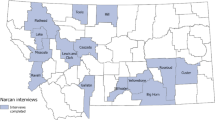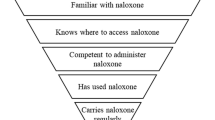Abstract
Training and distributing naloxone to drug users is a promising method for reducing deaths associated with heroin overdose. Emergency Medical Service (EMS) providers have experience responding to overdose, administering naloxone, and performing clinical management of the patient. Little is known about the attitudes of EMS providers toward training drug users to use naloxone. We conducted an anonymous survey of 327 EMS providers to assess their attitudes toward a pilot naloxone program. Of 176 who completed the survey, the majority were male (79%) and Caucasian (75%). The average number of years working as an EMS provider was 7 (SD=6). Overall attitudes toward training drug users to administer naloxone were negative with 56% responding that this training would not be effective in reducing overdose deaths. Differences in attitudes did not vary by gender, level of training, or age. Providers with greater number of years working in EMS were more likely to view naloxone trainings as effective in reducing overdose death. Provider concerns included drug users’ inability to properly administer the drug, program condoning and promoting drug use, and unsafe disposal of used needles. Incorporating information about substance abuse and harm reduction approaches in continuing education classes may improve the attitudes of provider toward naloxone training programs.
Similar content being viewed by others
References
Oppenheimer E, Tobutt C, Taylor C, Andrew T. Death and survival in a cohort of heroin addicts from London clinics: a 22-year follow-up study. Addiction. 1994;89: 1299–1308.
Caplehorn JR, Dalton MS, Cluff MC, Petrenas AM. Retention in methadone maintenance and heroin addicts’ risk of death. Addiction. 1994;89:203–209.
Donoghoe M, Hall W. Opioid overdose: Trends, risk factors, interventions, and priorities for action. Geneva, Switzerland: Wold health Organization; 1998.
Garfield J, Drucker E. Fatal overdose trends in major US cities: 1990–97. Addiction Res Theory. 2001;9:425–436.
Substance Abuse and Mental Health Administration. Mortality Data from the Drug Abuse Warning Network, 2000. Rockville, MD: Office of Applied Studies; 2002. DHHS Publication, No. (SMA) 02-3633; DAWN Series D-19.
Baltimore City Police Department. End of the year crime statistics. Available at: http://www.ci.baltimore.md.us/government/police/stats020102.html. Accessed February 1, 2002.
Darke S, Hall W. The distribution of naloxone to heroin users. Addiction. 1997;92: 1195–1199.
Burris S, Norland J, Edlin BR. Legal aspects of providing naloxone to heroin users in the United States. Int J Drug Policy. 2001;12:237–248.
Dietze P. Intranasal naloxone is an effective first line treatment for suspected opioid overdose in the prehospital setting. Paper presented at: 15th International Conference on the Reduction of Drug Related Harm; April 24, 2004; Melbourne, Australia.
Bigg D, Maxwell S. Enabling people to stay alive: an effective opiate overdose prevention program. Paper presented at: the Fourth National Harm Reduction Conference; December 1, 2002; Seattle, Washington, DC.
Seal KH, Hammond JP, Ciccarone D, Downing M, Thawley R, Edlin B. Providing naloxone to IDUs can save lives. Paper presented at: the Fourth National Harm Reduction Conference; December 1, 2002; Seattle, Washington, DC.
Dettmer K, Saunders B, Strang J. Take home naloxone and the prevention of deaths from opiate overdose: two pilot schemes. BMJ. 2001;322:895–896.
Seal KH, Downing M, Kral AH, et al. Attitudes about prescribing take-home naloxone to injection drug users for the management of heroin overdose: a survey of streetrecruited injectors in the San Francisco Bay Area. J Urban Health. 2003;80:291–301.
Strang J, Powis B, Best D, et al. Preventing opiate overdose fatalities with take-home naloxone: pre-launch study of possible impact and acceptability. Addiction. 1999;94:199–204.
Coffin PO, Fuller C, Vadnai L, Blaney S, Galea S, Vlahov D. Preliminary evidence of health care provider support for naloxone prescription as overdose fatality prevention strategy in New York City. J Urban Health. 2003;80:288–290.
Warner-Smith M, Darke S, Day C. Morbidity associated with non-fatal heroin overdose. Addiction. 2002;97:963–967.
Author information
Authors and Affiliations
Corresponding author
Rights and permissions
About this article
Cite this article
Tobin, K.E., Gaasch, W.R., Clarke, C. et al. Attitudes of emergency medical service providers toward naloxone distribution programs. J Urban Health 82, 296–302 (2005). https://doi.org/10.1093/jurban/jti052
Published:
Issue Date:
DOI: https://doi.org/10.1093/jurban/jti052




